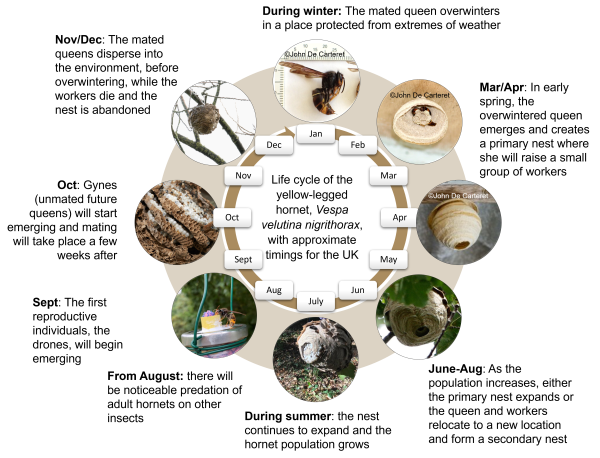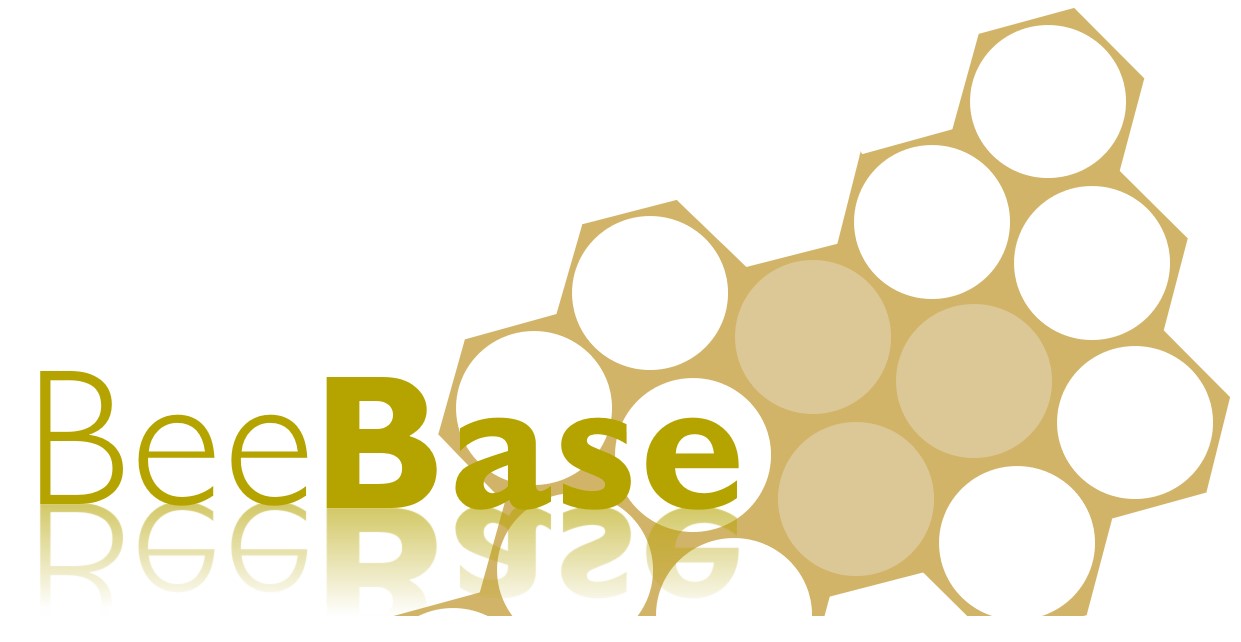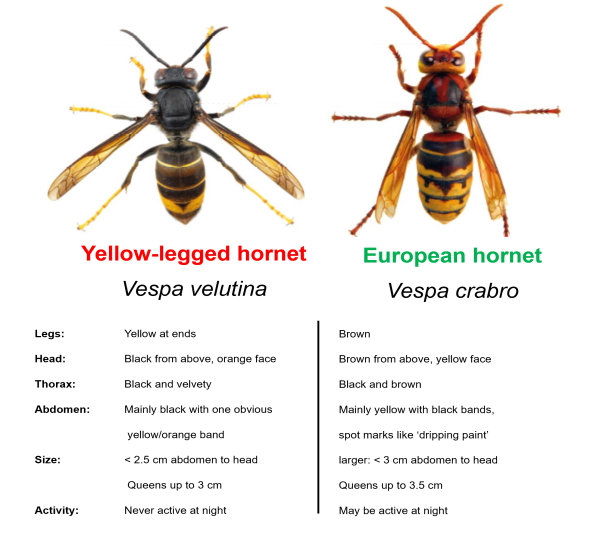This page briefly explains the background and life cycle of the yellow-legged hornet, also known as the Asian hornet. If you think you have seen the yellow-legged hornet, please go to the So you think you’ve seen a yellow-legged hornet page. If you would like to learn more about the role of Asian Hornet Teams, how they work with us to help raise awareness and identify potential sightings, and how to find your local AHT, please visit our The role of Asian Hornet Teams page. For the most up to date information on confirmed sightings of the yellow-legged hornet in the UK in 2024, please visit the 2024 rolling update page.
Background
Vespa velutina nigrithorax, also known as the yellow-legged hornet or the Asian hornet, was accidentally introduced into Europe from its native Asia. It was confirmed for the first time in Lot-et-Garonne in the South West of France in 2004. It was thought to have been imported in a consignment of pottery from China and quickly established and spread to many regions of France. As of December 2023, the hornet is established in France, Spain, Belgium, the Netherlands, Portugal, Italy, Switzerland, Germany and Jersey. The hornet preys on a wide range of insects including honey bees. It presents a risk to invertebrate diversity in areas where nests are present at high densities and can be a health risk to those who have allergies to hornet or wasp stings.
In 2016, the yellow-legged hornet was discovered in the UK for the first time, in Tetbury. After 10 days of intensive searching, the nest was found and later destroyed. In subsequent years there have been further sightings with action taken to find and destroy nests, detailed on our historic incursions page. In 2023, the UK experienced an unprecedented number of yellow-legged hornet incursions, our 2023 rolling updates page details the timeline of these incursions.
Appearance
The yellow-legged hornet is smaller than the European hornet, Vespa crabro, which is native to the UK. Adult yellow-legged hornet workers are approximately 25 mm in length, while European hornet workers tend to be approximately 30 mm in length. Yellow-legged hornet queens may be up to 30 mm long, while European hornet queens may be up to 35 mm. The yellow-legged hornet abdomen is mostly black except for the fourth abdominal segment which has a yellow band. It also has yellow legs and an orange face.
We rely upon members of the public to be able to recognise and report sightings of the yellow-legged hornet to help us contain this invasive pest. It is important to be able to distinguish it from native insects, such as the European hornet, to prevent erroneous reports from misidentification. You can access information on how to identify the yellow-legged hornet and distinguish it from native species from the following resources:
- ID Sheet
- ID Poster
- Postcard 1 (as image below, left)
- Postcard 2 (as image below, right)
- Nest ID

The life cycle
Spring
After hibernating over winter, the queen will emerge and seek out a sweet, carbohydrate-rich food source, in order to build up energy to commence building a small embryonic nest, called a primary nest. During construction of the nest, she is alone and vulnerable, but she will begin laying eggs to produce the future workforce. As the colony and nest size increases, a larger nest is either established around the embryonic nest or they relocate and build elsewhere; this is called the secondary nest.
Summer
During the summer, a single yellow-legged hornet colony can produce an average of 6000 individuals in one season. From July onwards, yellow-legged hornet predation on honey bee colonies will begin and increase until the end of November. Hornets predating on hives will be seen hovering outside a hive entrance, waiting for returning foragers. This is a characteristic hornet “hawking” behaviour. When they catch a returning bee, they will remove the wings, head and abdomen, and return to the nest with the protein rich thorax to feed the brood. The developing larvae are fed a protein-rich diet consisting of insects or other protein sources scavenged by the workers.
Autumn
During autumn, the nest activities shift from foraging and nest expansion to reproduction. In France, it was found that nests may produce up to 350 gynes (future queens) and three times as many male hornets. After the mating period, the newly fertilised queens will leave the nest and find somewhere suitable to over-winter. The old queen will die, leaving the nest to dwindle and die off. Of the gynes released by the nest, only a small number will successfully mate and survive the winter. The following spring, the founding queen will begin building her new colony and the process begins again.

Monitoring for the yellow-legged hornet
Observe the pollinators in your area and get used to identifying them. Place bait somewhere where it can be observed in the sun e.g. on a saucer near a seating area and watch hornets, flies, wasps and butterflies. Calmly watch what feeds. When insects are feeding it is easy to take a photo. For more information about monitoring for the yellow-legged hornet and instructions on how to make a monitoring trap, please see our Yellow-legged hornet monitoring fact sheet.
Report sightings
If you think you have seen an yellow-legged hornet, please report it using the free Asian Hornet Watch App, available for Android and iPhone, on the online notification form or by emailing alertnonnative@ceh.ac.uk. A photograph and the location of the sighting must be included. Please include your contact details so we can get in touch. For more information on how to report sightings, please visit our ‘So you think you’ve seen a yellow-legged hornet’ page.
Further Information
The yellow legged hornet, Vespa velutina, is sometimes confused with the Giant Asian hornet (Vespa mandarinia). Find out more in this Defra blog.
Yellow-legged hornet Awareness and Identification for Pest Controllers.
A Contingency Plan, which sets out the actions to be taken by Defra and the Welsh Government in response to suspected and confirmed outbreaks of yellow-legged hornet in England and Wales can be found here: Pest Specific Contingency Plan for Asian Hornet (Vespa velutina nigrithorax)
In order to get the latest information regarding the current yellow-legged hornet outbreak, please visit the Gov.uk rolling news page.

